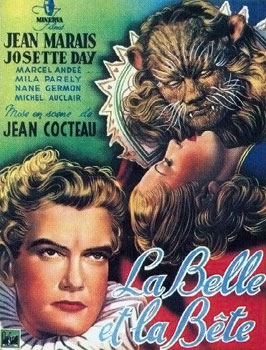Review-le belle et la bete
Fig.1.
Jean Cocteau’s le belle et la bete (1946) better known as Beauty and the beast is the film that inspired Disney’s Beauty and the beast. Simply put the film is a love story about belle (beauty) and La Bête (Beast), its narrative does not seem very unique or special, but what it lacks in story , it more than makes up for in art design and mise en scene.
Roy Armes said visually, “the film is one of Cocteau's most sophisticated works” (Roy Armes s.d), this statement is very true about the movie. Beast’s castle is a good example of the sophistication. It is visually stunning and the moving statues create a surreal experience for a spectator. Beast’s house feels cold and empty, even with all of the statues watching. This emptiness allows the viewer to take a look into beast’s psyche, it become apparent that the reason beast falls in love with beauty so quickly is because he is surrounded by extensions (the statues, his controls) of himself and has not had real human contact for a long time. His primal urges to find a mate also cloud his judgement. This can be characterised by Sigmund Freud’s Ego theory. Beast’s conscious mind is the ego, his identity is his animal instinct which forces him to hunt and his super ego is beauty. She is his voice of reasoning, Beauty being Beasts super ego helps explain why he fell in love with her so quickly, he needs her to be “whole”.
Fig.2.
Roger Ebert says “The Beast's dwelling is one of the strangest ever put on film” (Roger Ebert, 1999) this statement is quite true. The moving statues make the caste seem sinister at first and the idea that the castle is trapping Beauty gives the castle an eerie feeling. The idea of moving statues that follow your every move makes the castle seem haunted which adds to its creepiness. The rooms only seem to be lit by candle light, this is interesting as it helps make the castle seem more sinister, when in actual fact its not. The viewer is made to believe that the castle is quite tame. When beauty first interacts with the arm at the table, all it does is serve her a drink, this makes the statues feel less sinister and shows them as Beast’s servants.
Fig.3.
Geoffrey Macnab is very correct in saying “The costumes and some of the settings are ornate” (Geoffrey Macnab 2014)-, Pierre Cardin (costume designer) made very regal costumes which have two effects. Firstly it shows that beauty is living luxuriously, and secondly expresses the need for something more in the case of beauties sisters. Her sisters long to be rich again and because they have no money the only way to feel rich is to wear their old lavish clothing.
Illustration list
Figure. 1.Le belle et la bete (c.1946) [poster] at:http://upload.wikimedia.org/wikipedia/en/a/a4/La_Belle_et_la_B%C3%AAte_film.jpg
Figure 2.Le belle et la bete (c.1946) from Le belle et la bete, directed by: Jean Cocteau [film still] At. http://www.leninimports.com/jean_cocteau_la_belle_et_la_bete_gallery_8.jpg
Figure 2.la-belle (c.1946) from Le belle et la bete, directed by: Jean Cocteau [film still] At. http://www.leninimports.com/jean_cocteau_la_belle_et_la_bete_gallery_8.jpg
Bibliography
Geoffrey Macnab(02/01/2014)- La belle et la Bete: film review. At: http://www.independent.co.uk/arts-entertainment/films/reviews/la-belle-et-la-bete-film-review--cocteaus-forties-fantasy-is-still-a-thing-of-real-beauty-9035506.html( Accessed on 13/11/2014)
Roger Ebert(December 26, 1999)-Beauty and the beast reviews. At: http://www.rogerebert.com/reviews/great-movie-beauty-and-the-beast-1946( Accessed on 13/11/2014)
Roy Armes (s.d)– “visually, the film is one of Cocteau's most sophisticated” works:http://www.filmreference.com/Films-Aw-Be/La-Belle-et-la-B-te.html#ixzz3Iyb65TCh( Accessed on 13/11/2014)
Sigmund Freud (1941)-“an outline of psychoanalysis
Figure. 1.Le belle et la bete (c.1946) [poster] at:http://upload.wikimedia.org/wikipedia/en/a/a4/La_Belle_et_la_B%C3%AAte_film.jpg
Figure 2.Le belle et la bete (c.1946) from Le belle et la bete, directed by: Jean Cocteau [film still] At. http://www.leninimports.com/jean_cocteau_la_belle_et_la_bete_gallery_8.jpg
Figure 2.la-belle (c.1946) from Le belle et la bete, directed by: Jean Cocteau [film still] At. http://www.leninimports.com/jean_cocteau_la_belle_et_la_bete_gallery_8.jpg
Bibliography
Geoffrey Macnab(02/01/2014)- La belle et la Bete: film review. At: http://www.independent.co.uk/arts-entertainment/films/reviews/la-belle-et-la-bete-film-review--cocteaus-forties-fantasy-is-still-a-thing-of-real-beauty-9035506.html( Accessed on 13/11/2014)
Roger Ebert(December 26, 1999)-Beauty and the beast reviews. At: http://www.rogerebert.com/reviews/great-movie-beauty-and-the-beast-1946( Accessed on 13/11/2014)
Roy Armes (s.d)– “visually, the film is one of Cocteau's most sophisticated” works:http://www.filmreference.com/Films-Aw-Be/La-Belle-et-la-B-te.html#ixzz3Iyb65TCh( Accessed on 13/11/2014)
Sigmund Freud (1941)-“an outline of psychoanalysis





Hello!
ReplyDeleteOk, a couple of points.... firstly, don't forget to italicise your quotes. After the quote, you just need the author's surname and the year, so (Ebert, 1999) for example. When you come to put these names into the bibliography, the are shown surname first, then initial, and they are organised in alphabetical order, so in your case,
Armes, R.
Ebert, R.
Freud, S.
Macnab, G.
Your are still missing some of the info that you need in the bibliography (especially the Freud one!) Have another look at the referencing guide here - http://community.ucreative.ac.uk/Harvard-Referencing
You should also make sure that your images are labelled to correspond with your illustrations list, then you can refer to them within your text by saying for example ' ...as seen in figure 2'.